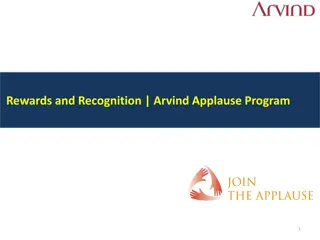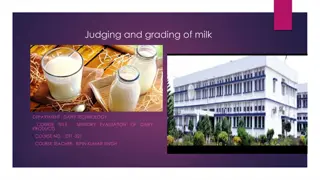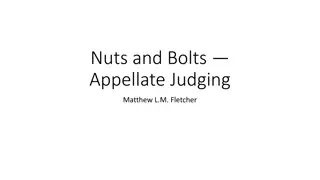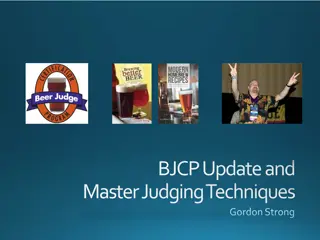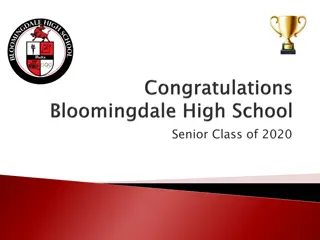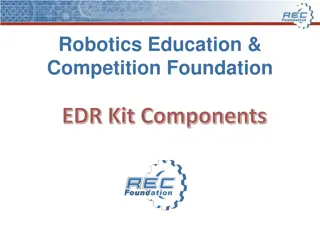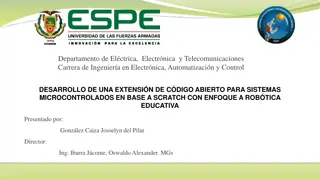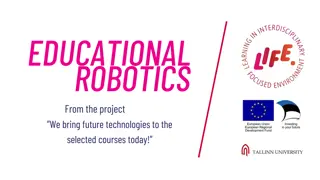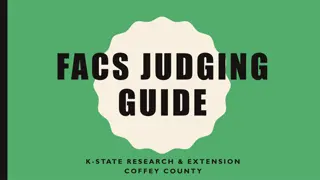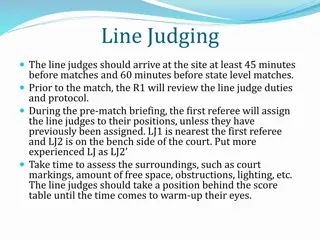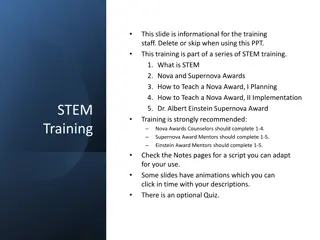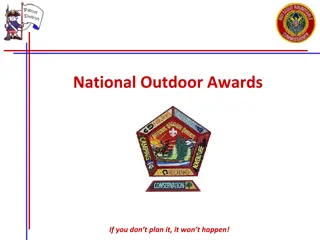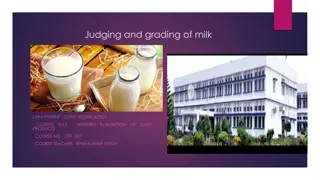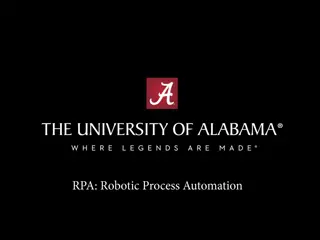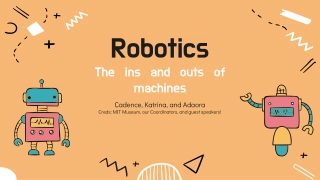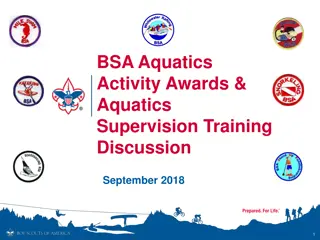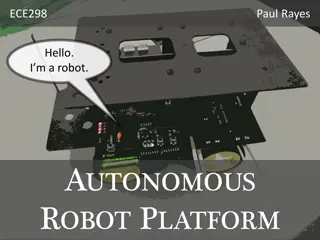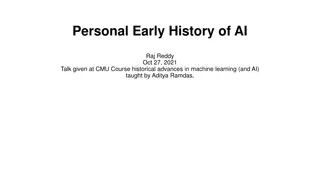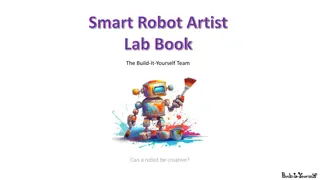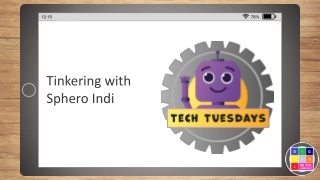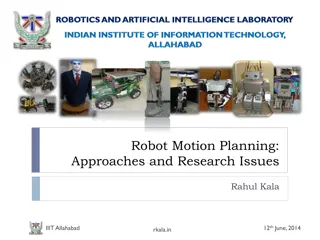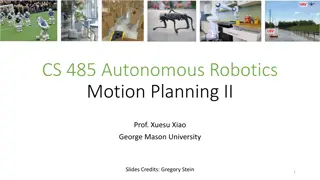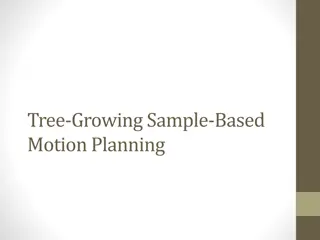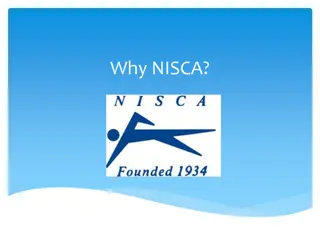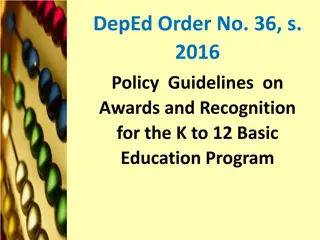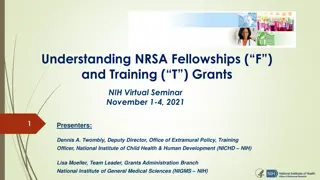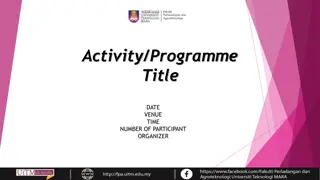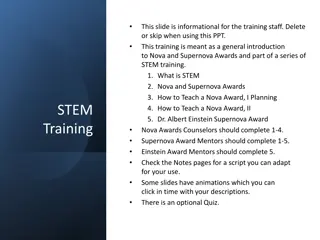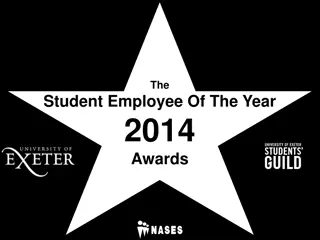Guide to Best Robotics Institute Awards and Judging Process
This guide provides valuable insights into the BEST Robotics Institute Awards and Judging process. It covers important aspects such as the philosophy behind the competition, awards overview, hints to improve scores, the significance of the Project Engineering Notebook, and the purpose of documenting the team's robot design process. By following these guidelines, teams can enhance their performance and chances of success in the competition.
Download Presentation

Please find below an Image/Link to download the presentation.
The content on the website is provided AS IS for your information and personal use only. It may not be sold, licensed, or shared on other websites without obtaining consent from the author. Download presentation by click this link. If you encounter any issues during the download, it is possible that the publisher has removed the file from their server.
E N D
Presentation Transcript
Teacher/Mentor Institute Awards & Judging Tami Kirkland / Lori Lazuk July 21-22, 2016
BEST Philosophy The students will get the most from the process if they do the work Mentors and Teachers should help the students realize the students ideas The six-week development process is more important than the game-day competition BEST does not stand for Beat Every Single Team BEAT EVERY SINGLE TEAM Page 2
2016 Awards Overview National Mandatory Awards Robot Competition Game requires Project Engineering Notebook Founders Award For Creative Design Most Robust Machine Software / Simulation Optional Awards by Hub Sportsmanship (RM/FR) Best Rookie Team (RM/FR) Craftsmanship (RM) Project Engineering Notebook (RM) Outreach (FR) Most Creative Exhibit (FR) Marketing Presentation (FR) BEST Award Team Participation is Optional Project Engineering Notebook 30 pts Marketing Presentation Team Exhibit and Interview Spirit and Sportsmanship Robot Performance For your team to compete in the BEST Award, you must notify us by 2 weeks after Kickoff 25 pts 20 pts 10 pts 15 pts Page 3
Hints to Improve Scores Use last year s Awards & Judging Policies: BEST Robotics File Manager- 2015 Awards and Judging Use the score sheets and rubrics to improve your performance & scores Schedule students & time into the plan to do the Engineering Notebook starting with day 1 of work Schedule time into your plan to practice your robot and review scoresheets Page 4
The Project Engineering Notebook (PEN) Its Importance & Judging Every team MUST submit a Project Engineering Notebook NO EXCEPTIONS This is a Notebook! (some assembly required) Page 5
Purpose of the Notebook Documents the process the team uses to design, build and test the team s robot. An opportunity to tell the story of your robot Documentation is a critical aspect of the Engineering Process. It provides A crucial record of the process Critical info to be shared among different subteams A checklist against requirements Essential information for new teammates Page 6 Page 6
A Notebook Required to Compete Project Engineering Notebooks are due on Practice Day If a notebook is not turned in on Practice Day, your team will NOT be able to compete on Game Day Notebooks will be returned on Game Day Page 7 Page 7
KEEP IN MIND that the PEN is A ticket to the Wild Card Match Just in case your robot had one of those moments 30% of the BEST Award score A significant % of Best Rookie Team score Impacts the Founders Award results A vital record of your team s work May also be useful in portfolios, applications, etc. Page 8
Judging the Notebook ALL notebooks are judged using the BRI score sheet & rubrics Use the score sheet to assist you in writing / organizing your notebook The Table of Contents should have a listing for each section on the score sheet section. This helps the Team and the Judges! Reference amplifying information in the appendix. Scoring process - each judge scores the same section on every team s notebook Page 9 Page 9
Notebook Examples Think like a judge in preparing the PEN! Review two sample notebook Table of Contents 2009 Wichita Homeschool 2012 STEM Academy Use the 2015 Score Sheet to discuss / evaluate the Table of Contents Added in 2015: Software Design and Simulation scoresheet part of PEN scoresheet Page 10
2015 PEN Score Sheet (1 of 3) Possible Points Purpose: To document the process used to design, build, and test the robot (30 Points) Score RESEARCH PAPER (4 Points) Correlation between game and how the science/technology is being used at a company/industry/research lab in the team s state or region Comments: Any related information of game theme, such as history, famous inventor(s), or major milestones. Comments: Creativity in linking game theme to appropriately related science content Comments: Proper use of grammar and composition throughout paper, citations of sources used to gather information for paper, stayed within 2-5 page limit Comments: DESIGN PROCESS (17 Points) Implementation of the Engineering Design Process Evidence that the engineering process was effectively used. Comments: Brainstorming Approaches How well organized and productive was the brainstorming approach used? How well was the brainstorming approach documented? Comments: Analytical Evaluation of Design Alternatives Use of analytical and mathematical skills in deciding upon and implementing design alternatives Comments: Offensive and Defensive Evaluation Analysis of gaming strategies and design elements used to achieve team goals Comments: 10 10 10 10 25 25 25 25 Page 11
2015 PEN Score Sheet (2 of 3) Software D&S Purpose: To document the software design process and practices used for creating and testing the robot program. (25 Points) SOFTWARE DESIGN PROCESS (180 points) Evidence of custom software design versus using the default robot program Comments: Evidence that a software design process was followed o Identifying the required operations (e.g., locomotion/drive, chassis rotate, arm lift/bend/rotate/extend, claw rotate/open, ...) o Designing each required operation (e.g., flow charting the steps involved) o Designing a user-interface (e.g., how the robot will be controlled) o Test planning (how correct operation of the robot program will be tested) Comments: Evidence of advanced testing and debugging techniques utilized to verify the correct operation of the robot program without depending solely on the physical robot (e.g., software simulation via Simulink, virtual world, software-in-the-loop, etc.) Comments: Evidence that the defined program functionality is applicable to the defined task(s). The program functionality maps clearly to the desired game strategies. Comments: SOFTWARE DESIGN PRACTICES (55 points) Consideration of good software design practices (e.g., commenting, naming conventions, code simplicity, modularity) Comments: Consideration of error conditions and response actions. (e.g., motor/servo stop limits, out of bounds values, etc.) Comments: Consideration of code portability and maintainability (e.g., use of variables vs. hardcoding values; use of functions, tasks and subsystems, etc.) Comments: CLARITY OF DESIGN AND DESCRIPTION (15 points) Clarity of design and description. Comments: Possible Points Score 50 50 50 30 25 15 15 15 Total 250 10 25 Page 12 10 Final score:
2015 PEN Score Sheet (3 of 3) Software Design and Simulation (from additional scoresheet) Evidence of custom software design vs default program; Demonstration of software design process; Evidence of use of simulation (e.g., Simulink) to verify correct operation of robot program; Consideration of good software design practices such as comments, naming conventions, design simplicity, modularity, portability, etc. Comments: (see Software Design and Simulation Scoresheet) Safety Evidence that safety training occurred and safe practices were followed to prevent students misuse of tools and other devices/equipment that may result in personal injury or damage to property Comments: Support Documentation CAD/other drawings, photos, team organization, meeting minutes, test results, etc. that support the main document (max 20 double-sided pages) Comments: OVERALL QUALITY AND COMPLETENESS OF NOTEBOOK (9 Points) Organization and appearance Table of contents, summary, page numbers, discussion of evaluation points, linkage to appendices Comments: Adherence to specifications Standard binder, business font no smaller than 12 pt., double-spaced (single spaced ok in tables and outlines), 30 one-sided page limit for main section, 20 double-sided page limit for appendices, 1 margins, required cover information. Comments: Quality of content Well written descriptions, clear photo labels, lack of extraneous material, etc. Comments: 25 20 25 30 30 30 Total 300 10 30 10 Final score: Page 13
Table of Contents Examples EXAMPLE 1 Wichita Homeschool 2009 1. Introduction 2. Research Paper 3. Implementation of the Engineering Process Stage 1 Gather Requirements Stage 3 Preliminary Design Stage 3 Final Design and Construction Stage 4 Test and Evaluation Brainstorming Approaches Analytical Evaluation of Design Alternatives Offensive and Defensive Evaluation Software Design and Simulation new in 2015 Design Creativity Summary Support Documentation Appendices EXAMPLE 2 STEM Academy 2012 1. Executive Summary 2. Design Process 2.1 Problem Statement 2.2 Overview of Engineering Design Process 2.3 Brainstorming 2.4 Strategy Evaluation 2.5 Robot Design 2.6 Mathematical Analysis 2.7 Programming 2.8 Simulation new in 2015 2.9 Robot Integration &Testing 3. Team Organization & Meeting Minutes 4. Safety 5. Research Paper 6. Appendix 1. 2. 3. 4. 4. 5. 6. 7. 8. 9. Page 14
PEN Judging Exercise Review the Brainstorming Approaches in the 2009 Project Engineering Notebook submitted by Wichita Home School Use the 2015 PEN Score Sheet Section Design Approach - Brainstorming Approaches on next page Use the 2015 Suggested Rubric on next page Page 15
Scoring Brainstorming Approaches 2015 Notebook Score Sheet: How well organized and productive was the brainstorming approach used and documented? 2015 Suggested Rubric: 21 - 25: Approach is explicitly identified. Organization and productivity are obvious. Explanation is thorough. 16 - 20: Approach is identified. Organization and productivity are discernible. There is some explanation. 11 - 15: Approach is not identified. There is some discussion of brainstorming. 6 - 10: Discussion of approach is minimal. 1 - 5: You can tell there were ideas generated. 0: No discernible brainstorming. Page 16
The BEST Award The BEST Award competition is evaluated by judges using score sheets using the following distribution of points: Project Engineering Notebook * 30 pts Marketing Presentation Team Exhibit and Interview Spirit and Sportsmanship Robot Performance TOTAL 25 pts 20 pts 10 pts 15 pts 100 pts * and Software Design and Simulation Scoresheet Page 17
The BEST Award Presented to the team that best embodies the concept of Boosting Engineering, Science and Technology Inclusiveness, Diversity of participation Use of the Engineering Process, Creativity Sportsmanship, Teamwork Positive attitude & enthusiasm School and community involvement Page 18
The BEST Award Teaches Business Related Skills Project Management Public Speaking Leadership Time Management Critical Thinking Documentation Strategic Planning Marketing Technical Writing Page 19
Important Deadline Participation in the BEST Award Competition is optional Sign up for BEST Award approximately 2 weeks after Kickoff Details will be provided at your hub s Kickoff Page 20


